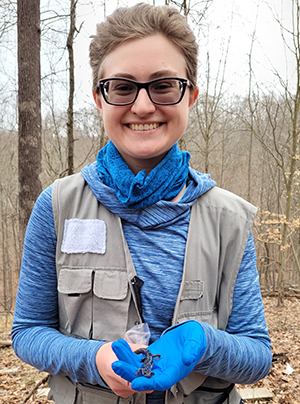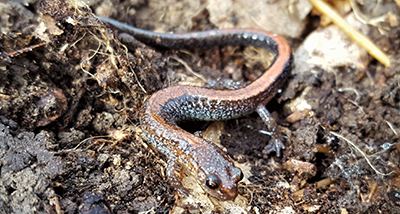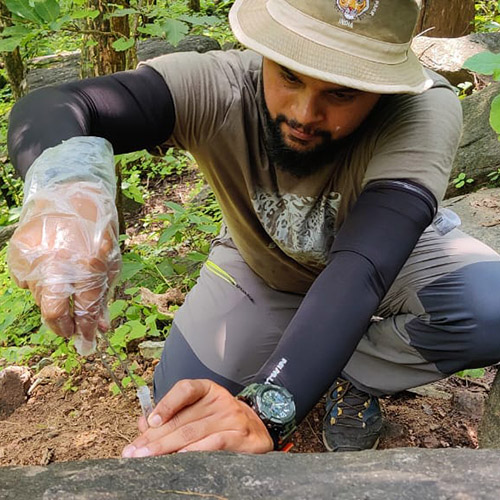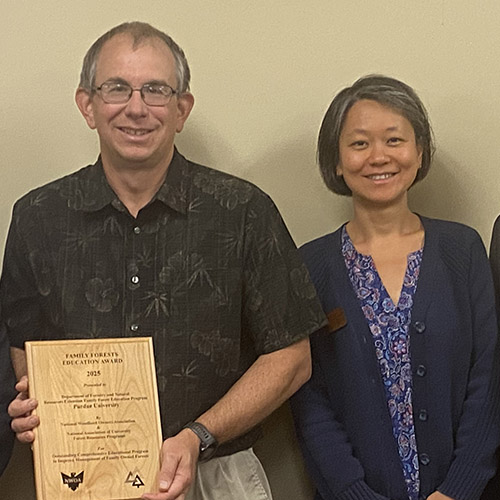How Do Terrestrial Salamanders Respond to Timber Harvest
The effects of planting or harvesting a tree often take time to see. What are the long-term effects on the forest ecosystem as a whole, and also on individual species within it?
 A new publication “Response of Terrestrial Salamanders to the Decade Following Timber Harvest in Hardwood Forests” by graduate research assistant/PhD candidate Alison Ochs along with associate professor of ecology and natural resources Mike Saunders and professor of wildlife science Rob Swihart examined an 11-year span at the Hardwood Ecosystem Experiment to answer that question.
A new publication “Response of Terrestrial Salamanders to the Decade Following Timber Harvest in Hardwood Forests” by graduate research assistant/PhD candidate Alison Ochs along with associate professor of ecology and natural resources Mike Saunders and professor of wildlife science Rob Swihart examined an 11-year span at the Hardwood Ecosystem Experiment to answer that question.
Why study salamander abundance? Salamanders, especially terrestrial salamanders such as plethodontids, are critical components of forest ecosystems and potential indicators of ecosystem changes due to their broad range, high densities and sensitivity to ecosystem changes. Salamanders rely on cool, moist conditions, which can be affected by the change in available leaf litter and coarse woody debris, as well as canopy cover.
“With salamanders and other amphibians on the decline, understanding how timber harvest affects these vulnerable species is critical,” Ochs said. “Our findings suggest that timber harvesting techniques that keep some canopy cover may help prevent salamander declines, and even help protect them from drought, a concern as such extreme weather events are growing more common. These findings may be useful to land managers who hope to conduct timber management sustainably without damaging delicate ecosystems and species. Land managers particularly concerned about salamander populations may consider using methods such as shelterwood harvesting rather than more impactful clearcutting.”
Methods
The Hardwood Ecosystem Experiment is a long-term, large-scale experimental study of forest management and its impact, which began in 2006. The 100-year project aims to find the ecological and social impacts of long-term forest management on public and private lands in Indiana and the Central Hardwood Region. The HEE features nine units located across the Morgan-Monroe and Yellowwood State Forests, which were analyzed prior to timber harvesting and the years following timber harvests. Units were assigned to utilize even-aged management, uneven aged management or as unharvested controls.
 Data was collected using artificial cover object grids beginning in the fall of 2007 to determine relative salamander abundance. The first harvests occurred in the winter of 2008. Data was collected in the fall (from mid-September to mid-November) and the spring (from the beginning of March to the end of April) each year through November 2014. Sampling then took place from the fall of 2015 through the spring of 2017 and paused, before resuming in March 2019.
Data was collected using artificial cover object grids beginning in the fall of 2007 to determine relative salamander abundance. The first harvests occurred in the winter of 2008. Data was collected in the fall (from mid-September to mid-November) and the spring (from the beginning of March to the end of April) each year through November 2014. Sampling then took place from the fall of 2015 through the spring of 2017 and paused, before resuming in March 2019.
Researchers utilized R for statistical computing and used a before-after-control-impact (BACI) design to examine the effects of harvest type on salamander captures with generalized linear mixed effects models.
Findings
Researchers looked at the effects of clearcuts, patch cuts and shelterwood harvests on salamander relative abundance from one year prior to the harvests and up to 11 years after the harvest. They found that no significant declines occurred in the first three years after the harvest, but salamander captures declined four to six years postharvest and also for seven to 11 years following clearcuts and patch cuts with no recovery. As the availability of coarse woody debris declined in the four years after the harvest, the number of salamanders captured also declined. However, a regional drought may have also impacted the salamander count, providing evidence that timber harvest and drought together may affect salamanders more than either alone.
“The failure to immediately react to timber harvest suggests that salamander response to timber harvest may take a few years to materialize and may be exacerbated by exogenous disturbances such as drought, or both... We detected evidence that drought can interact with timber harvesting, thereby causing profound effects on salamander populations by further increasing temperatures and lowering soil moisture already exacerbated by canopy loss.”
This publication covers the first section of Ochs’ dissertation which examines salamander responses to different aspects of forest management.
 “It will add to the literature on the subject, improving on previous work by adding more study years and robust statistical techniques, and will directly apply to Midwest hardwood forests rather than other, more commonly studied ecosystems that may behave differently,” Ochs said. “It provides an important look at the decade following timber harvest, rather than immediate or long-term effects, closing a gap between short- and long-term studies.”
“It will add to the literature on the subject, improving on previous work by adding more study years and robust statistical techniques, and will directly apply to Midwest hardwood forests rather than other, more commonly studied ecosystems that may behave differently,” Ochs said. “It provides an important look at the decade following timber harvest, rather than immediate or long-term effects, closing a gap between short- and long-term studies.”
The next part of Ochs’ project is to look at another aspect of forest management growing in use in the Midwest, prescribed fire, and its effects on salamanders.
Meanwhile, the ongoing timber harvest project on the HEE will continue with the third round of shelterwood harvests in the next few years. Researchers will continue monitoring salamanders before and after the harvest, which removes the remaining canopy from the previous harvests, to see if it has a stronger effect on the salamanders than what has been seen thus far.
“Hopefully we can continue monitoring salamanders long enough to begin to see signs of a recovery, which some studies have estimated may take at least 20 years following harvest,” Ochs said.






